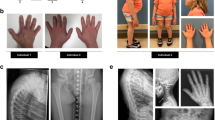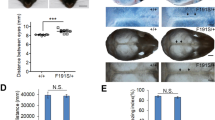Abstract
Tattered (Td) is an X-linked, semi-dominant mouse mutation associated with prenatal male lethality1. Heterozygous females are small and at 4–5 days of age develop patches of hyperkeratotic skin where no hair grows, resulting in a striping of the coat in adults2. Craniofacial anomalies and twisted toes have also been observed in some affected females3,4. A potential second allele of Td has also been described5. The phenotype of Td is similar to that seen in heterozygous females with human X-linked dominant chondrodysplasia punctata (CDPX2, alternatively known as X-linked dominant Conradi-Hünermann-Happle syndrome) as well as another X-linked, semi-dominant mouse mutation, bare patches (Bpa). The Bpa gene has recently been identified6 and encodes a protein with homology to 3β-hydroxysteroid dehydrogenases that functions in one of the later steps of cholesterol biosynthesis. CDPX2 patients display skin defects including linear or whorled atrophic and pigmentary lesions, striated hyperkeratosis, coarse lusterless hair and alopecia, cataracts and skeletal abnormalities including short stature, rhizomelic shortening of the limbs, epiphyseal stippling and craniofacial defects (MIM 302960). We have now identified the defect in Td mice as a single amino acid substitution in the Δ8-Δ7 sterol isomerase emopamil binding protein (Ebp; encoded by Ebp in mouse) and identified alterations in human EBP in seven unrelated CDPX2 patients.
This is a preview of subscription content, access via your institution
Access options
Subscribe to this journal
Receive 12 print issues and online access
$209.00 per year
only $17.42 per issue
Buy this article
- Purchase on Springer Link
- Instant access to full article PDF
Prices may be subject to local taxes which are calculated during checkout




Similar content being viewed by others
References
Cattanach, B.M. A new X-linked mutation, Td. Mouse News Letter 66, 61–62 (1982).
Uwechue, I.C. et al. The mouse X-linked developmental mutant, tattered, lies between DXMit55 and Xkh and is associated with hyperkeratinization. Genomics 37, 238–241 ( 1996).
Rasberry, C., Beechey, C. & Cattanach, B.M. Time of death of tattered males. Mouse Genome 93, 1028 (1995).
Uwechue, I.C. Analysis of X-linked mouse mutants. Thesis, Univ. Oxford ( 1997).
Seo, K.W., Miyoshi, H., Kon, Y. & Watanabe, T. Chromosomal mapping and developmental study of Tattered-Hokkaido (Tdho). Mamm. Genome 8, 578–580 (1997).
Liu, X.Y. et al. The gene mutated in bare patches and striated mice encodes a novel 3β-hydroxysteroid dehydrogenase. Nature Genet. 22, 182–187 (1999).
Merrell, K., Gonzales, J.C., Wells, S., Calame, K. & Herman, G.E. Genetic analyses of tattered, an X-linked dominant, developmental mouse mutation. Mamm. Genome 6, 291–294 (1995).
Silve, S. et al. Emopamil-binding protein, a mammalian protein that binds a series of structurally diverse neuroprotective agents, exhibits δ8-δ7 sterol isomerase activity in yeast. J. Biol. Chem. 271, 22434–22440 (1996).
Kelley, R.I. et al. Abnormal sterol metabolism in patients with Conradi-Hünermann-Happle syndrome and sporadic lethal chondrodysplasia punctata. Am. J. Med. Genet. 83, 213–219 (1999).
Hanner, M. et al. Phenylalkylamine Ca2+ antagonist binding protein. Molecular cloning, tissue distribution, and heterologous expression. J. Biol. Chem. 270, 7551–7557 (1995).
Labit-Le Bouteiller, C. et al. Antiproliferative effects of SR31747A in animal cell lines are mediated by inhibition of cholesterol biosynthesis at the sterol isomerase step. Eur. J. Biochem. 256, 342– 349 (1998).
Cho, S.Y., Kim, J.H. & Paik, Y.K. Cholesterol biosynthesis from lanosterol: differential inhibition of sterol Δ 8-isomerase and other lanosterol-converting enzymes by tamoxifen. Mol. Cells 8, 233– 239 (1998).
Kelley, R.I. RSH/Smith-Lemli-Opitz syndrome: mutations and metabolic morphogenesis. Am. J. Hum. Genet. 63, 322–326 (1998).
Yoshizawa, T. et al. Mice lacking the vitamin D receptor exhibit impaired bone formation, uterine hypoplasia and growth retardation after weaning. Nature Genet. 16, 391–396 (1997).
Jones, G., Strugnell, S.A. & DeLuca, H.F. Current understanding of the molecular actions of vitamin D. Physiol. Rev. 78, 1193– 1231 (1998).
Porter, J.A., Young, K.E. & Beachy, P.A. Cholesterol modification of hedgehog signaling proteins in animal development. Science 274, 255– 259 (1996).
Farese, R.V. Jr & Herz, J. Cholesterol metabolism and embryogenesis. Trends Genet. 14, 115–120 (1998).
Traupe, H. et al. Exclusion mapping of the X-linked dominant chondrodysplasia punctata/ichthyosis/cataract/short stature (Happle) syndrome: possible involvement of an unstable pre-mutation. Hum. Genet. 89, 659–665 (1992).
Clayton, P.T., Kalter, D.C., Atherton, D.J., Besley, G.T. & Broadhead, D.M. Peroxisomal enzyme deficiency in X-linked dominant Conradi-Hunermann syndrome. J. Inherit. Metab. Dis. 12, 358–360 ( 1989).
Holmes, R.D., Wilson, G.N. & Hajra, A.K. Peroxisomal enzyme deficiency in the Conradi-Hunerman form of chondrodysplasia punctata. N. Engl. J. Med. 316, 1608 (1987).
Blair, H. & Boyd, Y. Tcfe3 maps close to Gata1 on the mouse X chromosome. Mouse Genome 92, 511–512 (1994).
Kelley, R.I. Diagnosis of Smith-Lemli-Opitz syndrome by gas chromatography/mass spectrometry of 7-dehydrocholesterol in plasma, amniotic fluid and cultured skin fibroblasts. Clin. Chim. Acta 236, 45– 58 (1995).
Geraghty, M.T. et al. The isolation of cDNAs from OATL1 at Xp 11.2 using a 480-kb YAC. Genomics 16, 440–446 (1993).
Derry, J.M., Kerns, J.A. & Francke, U. RBM3, a novel human gene in Xp11.23 with a putative RNA-binding domain. Hum. Mol. Genet. 4, 2307–2311 (1995).
Acknowledgements
We thank R. Pauli, G. Wilson, C. Kalter, J. Atherton, R. Stratton, W. Wilson and M. Levy for sharing clinical information and providing blood or tissue samples from human CDPX2 patients; N. Braverman and D. Valle for sharing data concerning their CDPX2 families before publication; G. Morriss-Kay and D. Papworth for discussions; and T. Hacker, L. Hobbs, W. Masson and D. Silber for technical assistance. This work was supported by NIH R01 NS34953 and the Children's Hospital Research Foundation, The Ohio State University (G.E.H.), an MRC HGMP studentship (E.G.) and direct support from the MRC (E.G., Y.B.).
Author information
Authors and Affiliations
Corresponding author
Rights and permissions
About this article
Cite this article
Derry, J., Gormally, E., Means, G. et al. Mutations in a Δ8-Δ7 sterol isomerase in the tattered mouse and X-linked dominant chondrodysplasia punctata . Nat Genet 22, 286–290 (1999). https://doi.org/10.1038/10350
Received:
Accepted:
Issue Date:
DOI: https://doi.org/10.1038/10350
This article is cited by
-
Molecular landscape of congenital vertebral malformations: recent discoveries and future directions
Orphanet Journal of Rare Diseases (2024)
-
Ichthyosis
Nature Reviews Disease Primers (2023)
-
Role of Cholesterol and its Biosynthetic Precursors on Membrane Organization and Dynamics: A Fluorescence Approach
The Journal of Membrane Biology (2023)
-
Subcellular localization of sterol biosynthesis enzymes
Journal of Molecular Histology (2019)



